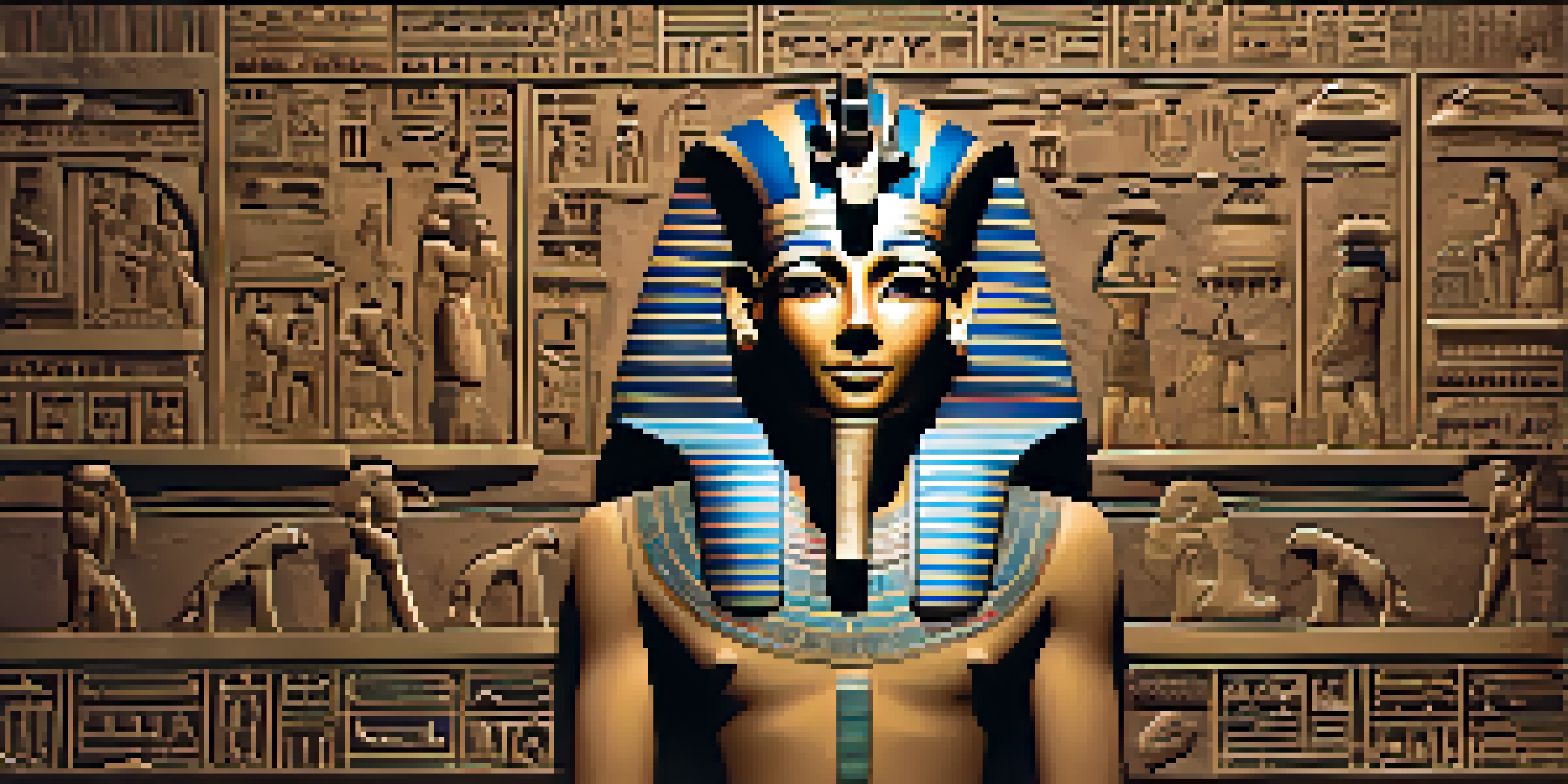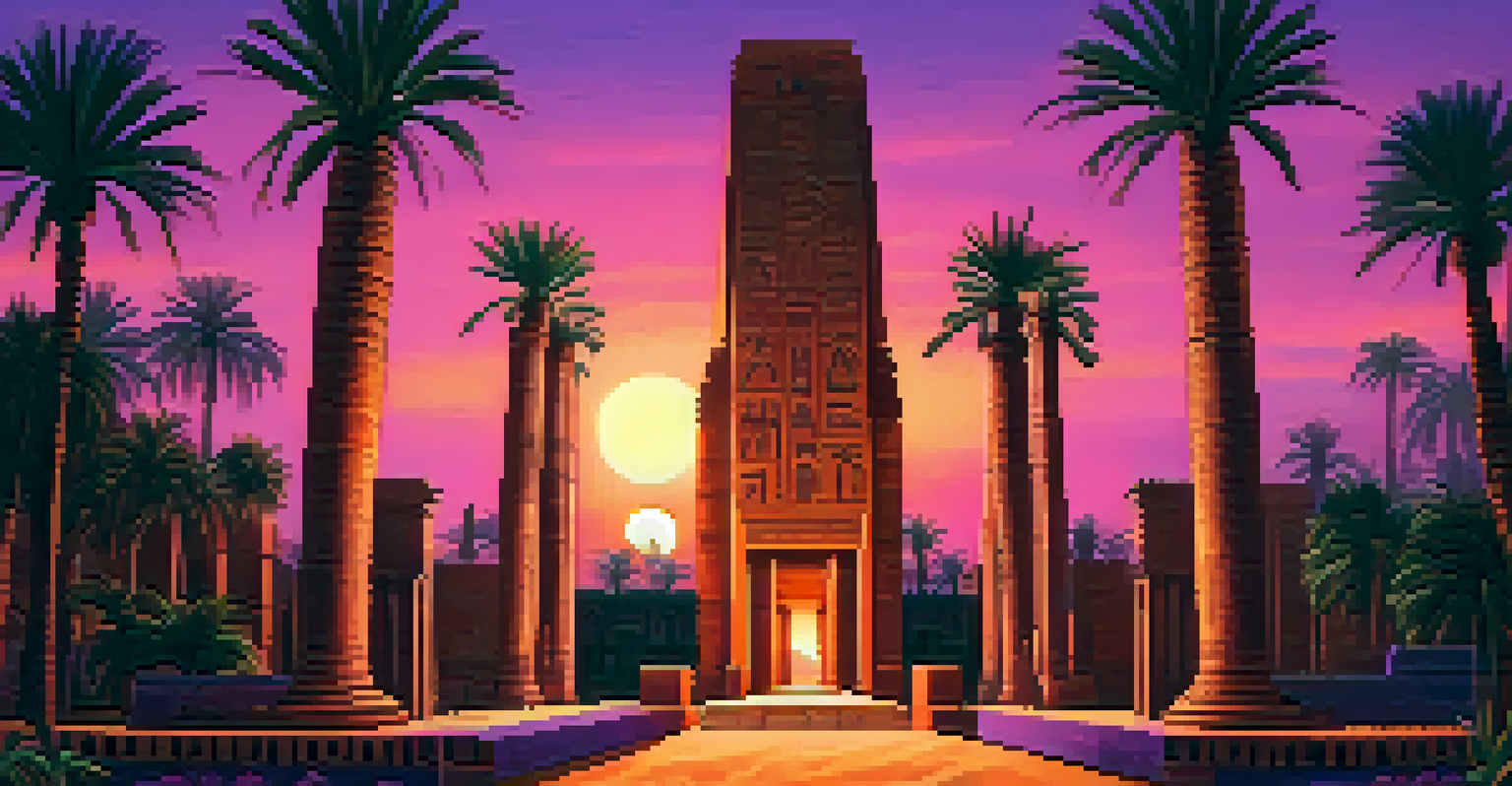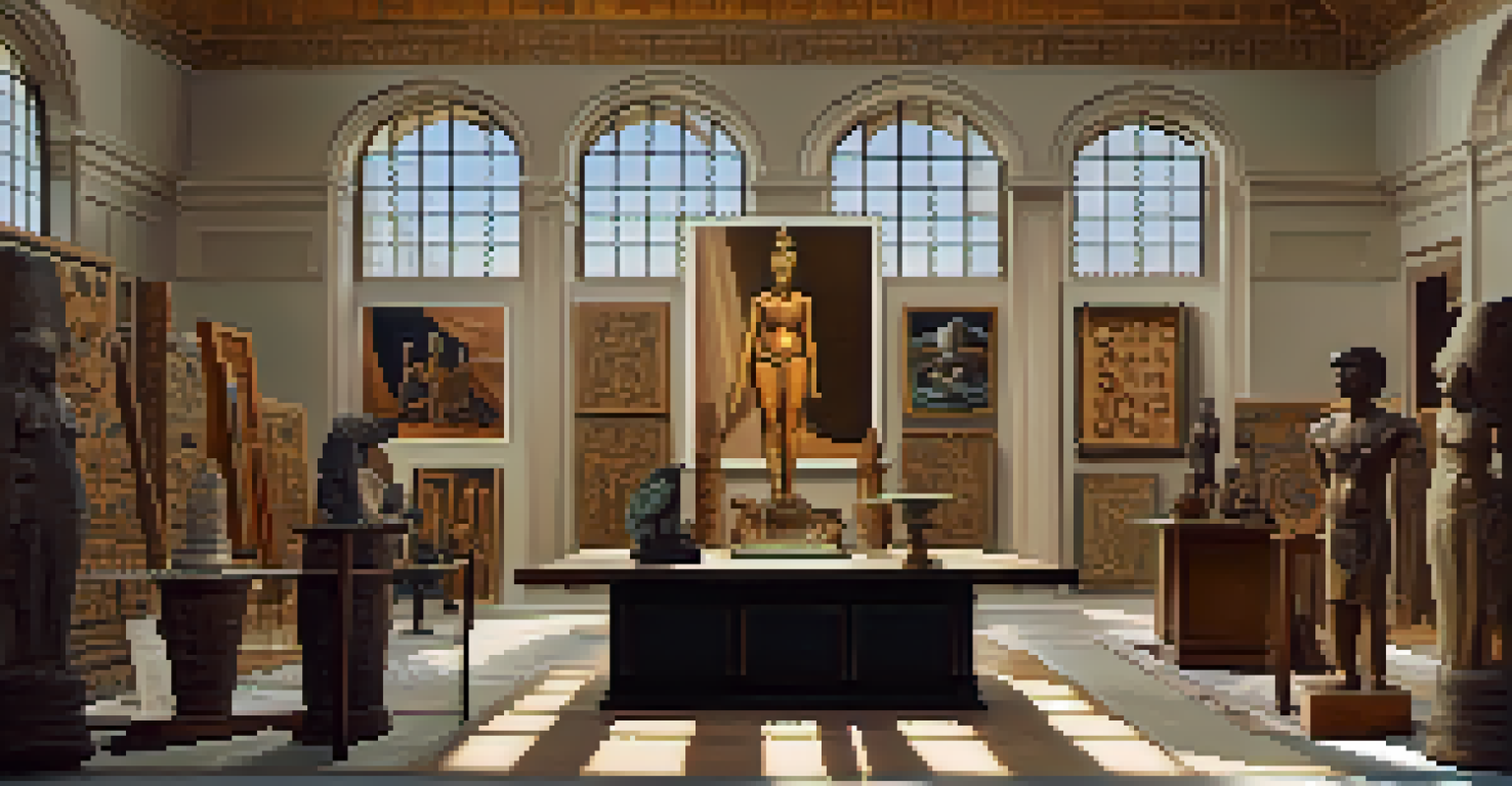The Influence of Egyptian Carvings on Later Civilizations

Understanding Egyptian Carvings and Their Significance
Egyptian carvings, often found in tombs and temples, are more than just art; they tell stories of gods, pharaohs, and daily life. These intricate designs served religious and ceremonial purposes, aiming to ensure a safe passage to the afterlife for the deceased. Each carving was meticulously planned, using symbolic representations that conveyed deep cultural meanings.
Art is the most beautiful of all lies.
The hieroglyphs, or sacred carvings, are a prime example of this storytelling. With hundreds of symbols, they communicated complex ideas and were often accompanied by vivid imagery that brought scenes to life. This visual language not only preserved history but also reflected the values and beliefs of ancient Egyptian society.
As we delve into the influence of these carvings on later civilizations, it's crucial to recognize their role as a bridge between art and spirituality. They set the foundation for how art would be used in religious contexts across cultures, inspiring generations of artists and storytellers.
The Adoption of Egyptian Styles in Ancient Greece
When we think of ancient Greece, we often envision marble statues and grand temples, but Egyptian influence is evident in their art as well. Greek artists admired the bold colors and stylized forms of Egyptian carvings, often incorporating similar elements into their own work. This blend of styles marked a significant evolution in Greek artistry, leading to the iconic sculptures we recognize today.

For instance, the use of drapery in Greek sculptures can be traced back to the way Egyptian carvings depicted clothing. While Egyptian figures were often rigid and frontal, Greek artists began to experiment with movement and naturalism influenced by their Egyptian predecessors. This shift not only highlighted the human form but also set the stage for future artistic movements.
Egyptian Carvings as Cultural Narratives
Egyptian carvings serve as intricate stories that capture the essence of ancient beliefs, values, and daily life.
Moreover, the Egyptians’ emphasis on idealized beauty and symmetry resonated with Greek ideals, shaping their approach to aesthetics. The admiration for Egyptian art can be seen in how Greek temples were designed, often adopting similar monumental styles that emphasized grandeur and spirituality.
Roman Emulation of Egyptian Art and Architecture
The Romans, known for their engineering marvels, were also deeply influenced by Egyptian art and architecture. As they expanded their empire, they encountered Egyptian culture and quickly embraced its artistic styles. Egyptian motifs, such as obelisks and sphinxes, became prominent in Roman architecture, symbolizing power and divine favor.
The past is never dead. It's not even past.
One notable example is the adoption of the Egyptian obelisk. The Romans transported these towering structures to cities like Rome, where they were erected in public spaces to showcase their dominance. This practice not only demonstrated Roman engineering prowess but also their reverence for Egyptian culture as a source of inspiration.
Additionally, Roman frescoes and mosaics often depicted Egyptian themes and deities, blending them into their own artistic narrative. This fusion of styles highlights how Egyptian carvings provided a visual vocabulary that transcended cultural boundaries, influencing Roman art and architecture significantly.
The Revival of Egyptian Influence During the Renaissance
Fast forward to the Renaissance, a period marked by a renewed interest in the classical world, and we find Egyptian art making a comeback. Artists and scholars sought inspiration from ancient civilizations, including Egypt, leading to a revival of its motifs and styles. This fascination was fueled by archaeological discoveries and the translation of ancient texts.
Renaissance artists such as Raphael and Michelangelo incorporated elements of Egyptian design into their works, reflecting a blend of ancient wisdom and contemporary artistry. The use of hieroglyphs and Egyptian figures in their paintings and sculptures brought a sense of exoticism and intrigue to their art. This period marked a significant turning point in how Egyptian aesthetics were perceived and adapted.
Influence on Greek and Roman Art
The stylistic elements of Egyptian art significantly shaped the development of Greek and Roman artistic traditions.
Moreover, the fascination with Egypt during the Renaissance paved the way for later movements, including Neoclassicism, where artists continued to draw from ancient styles. This enduring legacy shows how the Egyptian carvings not only influenced their contemporaries but also left an indelible mark on future generations of artists.
Impact on Modern Art and Pop Culture
Today, the influence of Egyptian carvings can still be seen in modern art and pop culture. Artists continue to draw inspiration from the bold lines and symbolic imagery that characterize Egyptian art. This revival is evident in contemporary works that seek to capture the mystique and grandeur of ancient Egypt, blending it with modern techniques and themes.
Moreover, Egyptian motifs have found their way into fashion, jewelry, and graphic design, reflecting a timeless appeal that resonates with audiences. Designers often incorporate hieroglyphic patterns and Egyptian imagery, creating a fusion of ancient and modern aesthetics that captivates the imagination.
In pop culture, films, books, and video games frequently reference Egyptian themes, showcasing the enduring fascination with this ancient civilization. From blockbuster movies featuring pharaohs and pyramids to graphic novels that explore Egyptian mythology, the influence of these ancient carvings continues to thrive in new and exciting ways.
Preserving the Legacy of Egyptian Carvings Today
As we appreciate the rich legacy of Egyptian carvings, it's essential to focus on preservation efforts. Many ancient sites and artifacts are threatened by environmental factors and human activity, making conservation vital. Organizations and governments are working diligently to safeguard these treasures, ensuring that future generations can experience their beauty and significance.
Educational initiatives play a crucial role in raising awareness about the importance of preserving Egyptian art. Museums around the world host exhibitions that highlight these carvings, fostering a deeper understanding of their historical context and cultural relevance. By engaging the public, they inspire a sense of responsibility towards protecting these irreplaceable pieces of history.
Modern Resonance of Egyptian Art
Today, Egyptian motifs continue to inspire contemporary artists, fashion designers, and popular culture, showcasing their lasting appeal.
Moreover, advancements in technology, such as digital archiving and 3D modeling, offer new ways to study and preserve Egyptian art. These tools allow researchers to analyze carvings in greater detail and share their findings with a global audience. This blend of tradition and innovation ensures that the influence of Egyptian carvings will endure for centuries to come.
Conclusion: The Enduring Power of Egyptian Art
In conclusion, the influence of Egyptian carvings on later civilizations is a testament to the power of art as a universal language. From the ancient Greeks and Romans to modern artists, the legacy of these carvings continues to inspire and resonate. They not only provide a glimpse into the past but also connect us to shared human experiences and aspirations.
As we explore this rich tapestry of influence, it's clear that Egyptian art has transcended time and geography. Its bold imagery, symbolic meanings, and spiritual significance have left an indelible mark on cultures worldwide. The stories told through these carvings echo through the ages, reminding us of the creativity and ingenuity of ancient civilizations.

Ultimately, the enduring appeal of Egyptian carvings lies in their ability to bridge the past and present. As we celebrate their influence, we are reminded of the importance of preserving this art form for future generations, ensuring that the stories they tell will continue to inspire and captivate.